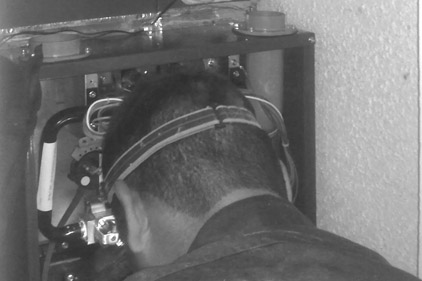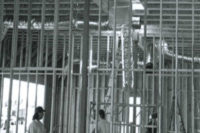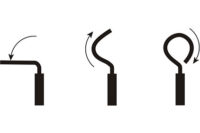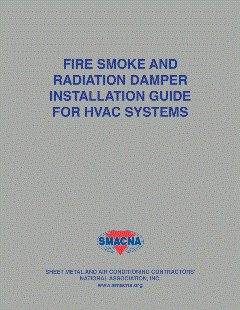Emergency Procedures
On construction jobs, the general contractor is required to have a first aid kit and at least one person trained in first aid. You should always know where the fire extinguishers are located.
If you work in homes, have a first aid kit and a fire extinguisher in your truck. Keep a fire extinguisher next to you when brazing a line set. Have a list of emergency numbers where help can easily be located. It is good idea for you to be trained in first aid.
Clothing and Safety Gear
A neat appearance is important when working in someone’s home. Many contractors think that it is so important that they supply company uniforms for all their employees. Always follow these safety rules:
• Wear high top, leather work shoes, preferably with steel toe protection.
• Wear long pants. Shorts are not acceptable.
• Wear protective sleeves when cutting sheet metal.
• Avoid loose clothing, which can increase your chances of being caught by moving machinery.
• If your hair is long, tuck it up under a hat or cap.
• Always carry safety goggles and use them whenever there is danger to the eyes, especially when working on electricity, when pounding or sawing, or when working overhead or in a dirty, dusty environment.
• You are required to wear a hard hat on any construction project.
• Wear ear protection if you are working in a noisy area. Prolonged exposure to noise leads to hearing loss.
Fall Protection

|
| Figure 1. Fall protection gear. |
Some installations are on roofs. The Occupational Safety and Health Administration (OSHA) requires that anyone working on a pitched roof over 10 feet above the ground must wear fall protection gear. This consists of a safety harness and a lanyard that is attached to an approved attachment point (Figure 1).
Electricity
When installing a residential furnace, you will normally be working with 120 volt circuits. However, if an air conditioning unit is part of the system, the circuit may be 240 volts.
Never work on a live circuit. An electrical shock is never pleasant. Under certain conditions, even a 120 volt shock can stop the heart. Be aware that you can get a shock from the neutral wire as well as the hot wire.
Always carry a volt-ammeter to measure the circuit voltage and also to check that a circuit is dead. Even though you have thrown a switch or a circuit breaker, always test the circuit to be sure that it is dead before you work on it. If a switch has been wired improperly (with the neutral wire through the switch) the circuit may still be live.
Electricity always seeks the easiest path to ground. If you receive an electrical shock and are well grounded, the shock will be severe. Water is an excellent conductor of electricity, so if your shoes are wet, you will receive a severe shock. The same is true if you are touching steel in a structure. On the other hand, if you are standing on a dry board or wearing dry shoes with insulating soles, the shock will be minimal.
Lock Out, Tag Out

|
| Figure 2. An outlet for an extension cord should be a GFCI. |
You may have to turn the power off at the circuit breaker panel in order to kill the furnace electrical circuit. Many residential breaker panels do not have each breaker switch properly labeled to show what circuit each controls. This means a trial and error process of switching off a breaker and checking to see what circuit is dead.
Before turning off breaker switches, make everyone in the home aware that there may be a temporary power outage for some house circuits.
If you shut off a switch or breaker, tag it so that no one will turn it on while you are working on equipment. On a construction job, lock the switch handle with your padlock and attach a warning tag. On a residential job, attach a warning note to the breaker switch so that no one will activate the breaker.
GFCI
A ground fault circuit interrupter (GFCI) is an electrical outlet that provides the surest protection against electrical shocks. The GFCI senses an electrical short by detecting an imbalance of the current between the hot and neutral lines of the circuit. When a short is detected, the GFCI shuts down the circuit instantly.

|
| Figure 3. GFCI adaptor that plugs into a wall outlet. |
An outlet for an extension cord should be a GFCI (Figure 2). If it is not, use a GFCI adaptor that plugs into a wall outlet (Figure 3), or use a “pig tail” adaptor (Figure 4). You should never use extension cords or power tools without a GFCI.
Do not take chances with damaged cords or defective tools. Have them replaced immediately. Even 120 volts can kill. Even if a shock does not kill, it could cause you to jerk, which could cause you to fall or contact moving equipment.

|
| Figure 4. A “pig tail” adaptor for a GFCI. (Courtesy Tower Mfg. Corp.) |
Fuel Safety
You may have to shut off the main fuel supply to the residence in order to connect the piping to the furnace. Notify the homeowner before you do. Determine what other appliances (such as water heaters and stoves) operate from the same fuel. You will have to relight these when you turn the fuel back on.
Test all new pipe connections with a detector or soapy water to be sure there are no leaks.
Natural gas can accumulate in closed spaces, such as in the furnace. If there is any possibility that leakage has occurred, shut off the gas service and allow at least five minutes for the gas to disperse before attempting any ignition.
LPG is heavier than air. If there is a leak, the gas will settle to the lowest area and remain there until it is removed by ventilation.
If you have to use any type of lighted torch, it is critical to have a fire extinguisher close at hand. Insulation or other parts of the house could catch fire.
Confined Spaces
Working in areas that have little or no ventilation can be dangerous:
• Inadequate oxygen in a space can result in unconsciousness and even death.
• Toxic chemicals (such as paint thinners and cleaners) are especially dangerous in a confined space.
If you must work in a confined space, use a fan for ventilation.
Excerpted and reprinted from Installing Residential Forced Air Furnaces by Leo A. Meyer with Michael Bugaeff, one of the books in the Indoor Environment Technician’s Library series published by LAMA Books.
Publication date: 8/6/2012










